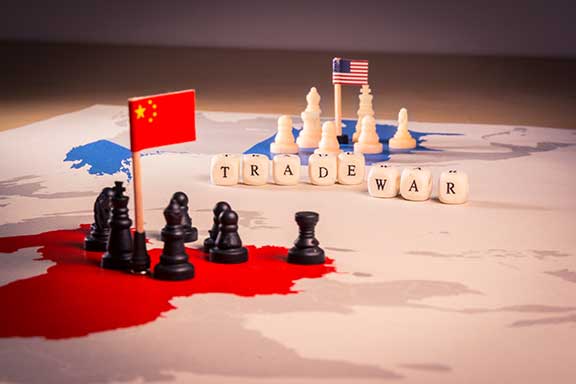
January 31, 2019
By Scott Paul, President | Alliance for American Manufacturing
The Trump administration for months now has held tariffs on steel and aluminum imports. They’ve caused a lot of worry in downstream industries, who worry the tariffs will cause price spikes that they’ll have to swallow – or pass on to customers.
On a separate track, many are worried the administration’s trade talks with China will fail and significant tariffs will cause similar, economy-wide results.
So far, though, spikes haven’t appeared, and the steel and aluminum tariffs are instead having their stated effect: to increase metals production in the United States. Significant capital investment is happening in the domestic steel industry, and our once-moribund aluminum industry is experiencing a relative bloom of new smelters.
That’s undeniably a good thing. I see these results as a market correction, after years of state-driven overcapacity flowing out of China’s own steel and aluminum industries, that was long overdue. All the new manufacturing employment and investment that will come from this reshoring will only benefit the wider economy.
But if we don’t take advantage of the current environment and create a healthy – and lasting – ecosystem for American manufacturing, it will be a missed opportunity of significant proportions.
President Trump has talked plenty about how important he considers manufacturing to his economic agenda. If that’s true, he needs to do more to shore it up.
Let’s be honest – while the economic results of the tariff tactics have thus far been good, this strategy has benefited from wonderful timing. The general economy is doing well, and manufacturing is booming – and was beginning to pick up steam before either the tariffs or the Republican tax plan settled into place.
To me, that means it’s going to take more than tariffs to make manufacturing’s rebound last. And there’s where the problem lies: Washington simply isn’t doing enough to prepare for long-term manufacturing success.
We need Congress to fully fund that success, and that means a truly massive investment in public infrastructure. Infrastructure spending is devolving into an unfortunate joke in American politics – often discussed, rarely pursued, and always shrugged at. But the fact remains that we really do need roads repaved, bridges rebuilt, and water and electric utilities laid and serviced. And we need the government to guarantee this market for infrastructure-related goods with a long-term bill so manufacturers will have the time to supply them.
What’s more, we need those investments to be American-made. That means strict “Buy America” procurement rules to encourage domestic manufacturing. These are remarkably popular policies that give American workers the first shot at taxpayer-funded contracts, and they’re fair; they include waivers if a domestic manufacturer can’t be found, or a domestic contract isn’t offered that’s close to market value.
The odds of this kind of infrastructure passage being passed in this kind of political environment are admittedly long. But there’s another opportunity playing out right now: the trade fight against China, which the administration is pursuing unilaterally.
President Trump and his advisers, particularly U.S. Trade Representative Robert Lighthizer, deserve a mountain of credit for identifying China as a mercantilist state that has pursued for decades beggar-thy-neighbor trade policies. China’s leaders have used bait-and-switch tactics, promising market liberalization (not to mention access) to their foreign counterparts for nearly 20 years now. They rarely deliver. But the Trump administration’s threat of significant tariffs on nearly all Chinese imports have brought China’s leadership to the table.
There’s something to be said for unilateralism: The administration is able to act more decisively in its negotiations when it doesn’t have to confer with partners on the best course of action. But there’s significant downside to going it alone, too: it will be very difficult to hold China – home of the world’s second largest economy, which continues to grow exponentially despite recent growth slowdowns – to its promises on our own.
An aggressive allied effort against Chinese mercantilism is more likely to keep China honest and produce a lasting trade reset than one negotiated on our own. It’s not too late to build one, but this White House has shown no interest in doing so. That, I’m afraid, will be a long-term mistake.
American manufacturing created more than 280,000 jobs last year. That’s an impressive clip, and the Trump administration should be proud of overseeing it. But it and the rest of our lawmakers in Washington are leaving the potential for even more growth on the table. Our economy needs infrastructure investment, and a trade fix with China that will stand the test of time.
Right now, I doubt it will get either.
 Scott Paul is the president of the Alliance for American Manufacturing, a unique nonprofit partnership established in 2007 by some of America’s leading manufacturers and the United Steelworkers union. Follow him on Twitter at @ScottPaulAAM.
Scott Paul is the president of the Alliance for American Manufacturing, a unique nonprofit partnership established in 2007 by some of America’s leading manufacturers and the United Steelworkers union. Follow him on Twitter at @ScottPaulAAM.
In this episode, I sat down with Beejan Giga, Director | Partner and Caleb Emerson, Senior Results Manager at Carpedia International. We discussed the insights behind their recent Industry Today article, “Thinking Three Moves Ahead” and together we explored how manufacturers can plan more strategically, align with their suppliers, and build the operational discipline needed to support intentional, sustainable growth. It was a conversation packed with practical perspectives on navigating a fast-changing industry landscape.